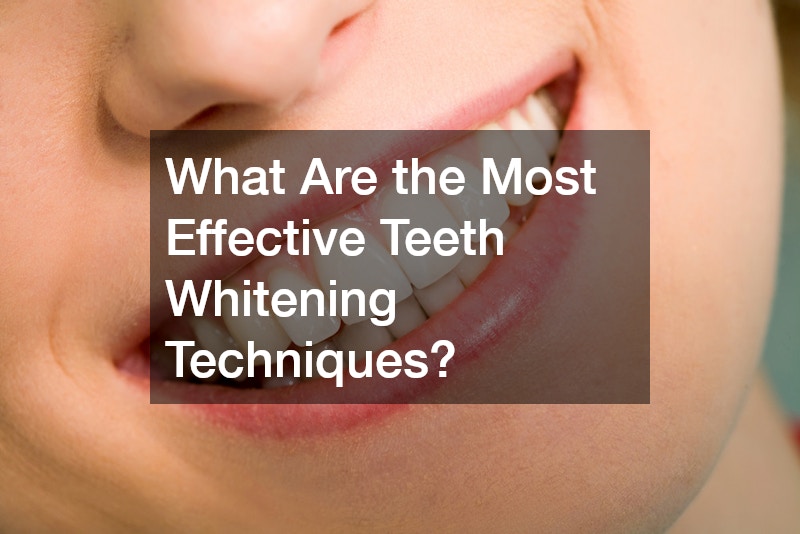Teeth whitening is one of the most popular cosmetic dental treatments available today, offering a relatively simple way to boost your smile and overall confidence. Whether you’re preparing for a big event or just want to enhance your appearance, a whiter smile can make a noticeable difference.
But with so many products and procedures on the market, it can be hard to know which methods actually work.
This guide explores the most effective teeth whitening techniques, from at-home solutions to professional treatments, so you can make an informed choice based on your needs, lifestyle and budget.
Professional Whitening Treatments
One of the most effective ways to achieve noticeable results is through professional teeth whitening performed by a dentist. These treatments use high-concentration bleaching agents that aren’t available over the counter. Dentists apply these solutions safely and evenly, often combining them with LED or laser technology to accelerate the whitening process.
In-chair whitening can provide dramatic results in just one visit, making it ideal for those looking for quick improvements before a wedding, job interview or other special occasion. Results can vary depending on the level of staining and the condition of the enamel, but many people notice a significant improvement in just one hour.
Dentists also offer take-home whitening kits, which are more powerful than store-bought options but allow for more flexibility. These kits usually include custom-fitted trays and a professional-grade gel to be applied over several days or weeks. While not as immediate as in-chair whitening, they still deliver strong results and are often recommended for maintaining the brightness achieved in the clinic.
Whitening Toothpastes and Over-the-Counter Products
Whitening toothpastes are among the most accessible products, found in nearly every supermarket or pharmacy. While they don’t contain bleaching agents, they use mild abrasives or polishing agents to remove surface stains caused by coffee, wine, smoking or certain foods.
Because of their limited strength, whitening toothpastes won’t drastically change the colour of your teeth, but they can be a helpful part of a broader teeth whitening routine. They’re best used as a maintenance method to keep your smile fresh between deeper treatments.
Over-the-counter whitening strips and gels contain small amounts of peroxide and are applied directly to the teeth. These products can be effective when used consistently, though results tend to be less dramatic and take longer to appear compared to professional treatments. It’s important to follow instructions carefully to avoid uneven results or increased tooth sensitivity.
Natural Remedies and Lifestyle Changes
There are also natural approaches that claim to whiten teeth, such as brushing with baking soda, using hydrogen peroxide rinses or oil pulling with coconut oil. While these methods have gained popularity online, their effectiveness varies and some can be abrasive or irritating if overused.
Baking soda, for example, can help lift surface stains but may damage enamel if used too aggressively. Hydrogen peroxide can whiten teeth in low concentrations, but can also cause gum irritation if applied improperly.
A better long-term strategy involves making small lifestyle adjustments to prevent staining in the first place. Reducing consumption of highly pigmented foods and beverages like red wine, black coffee and dark berries can limit new stains. Quitting smoking also significantly reduces the chances of yellowing teeth. Brushing twice a day, flossing and regular dental cleanings are all essential steps for maintaining natural whiteness.
Understanding the Risks and Limits
It’s important to remember that not all teeth whiten evenly. Fillings, crowns and veneers don’t respond to whitening agents and may require replacement to match your newly whitened teeth. In some cases, intrinsic stains caused by trauma or medication may not respond well to conventional methods and might require alternative solutions such as veneers or bonding.
Tooth sensitivity is a common side effect of whitening treatments, particularly those that involve bleaching agents. Most sensitivity is temporary and can be managed with toothpaste for sensitive teeth or by spacing out treatments. Your dentist can provide personalised advice if sensitivity becomes a concern.
It’s also worth noting that results vary from person to person. Age, diet, oral hygiene and even genetics play a role in how well your teeth respond to whitening. Setting realistic expectations is key to being satisfied with your outcome.
Final Thoughts
When it comes to teeth whitening, there is no one-size-fits-all solution. The best method depends on your specific needs, goals and oral health history. Professional treatments offer the fastest and most dramatic results, while over-the-counter products and natural methods can help maintain a bright smile over time.
Speaking with your dentist is the most reliable way to determine which teeth whitening technique is best suited for you. They can evaluate your dental health, explain your options and help you create a personalised plan that fits your lifestyle.
No matter which path you choose, a whiter smile is within reach with the right combination of care, consistency and professional advice.



